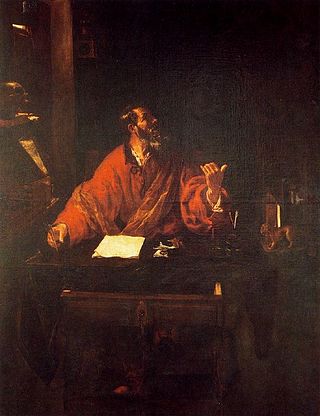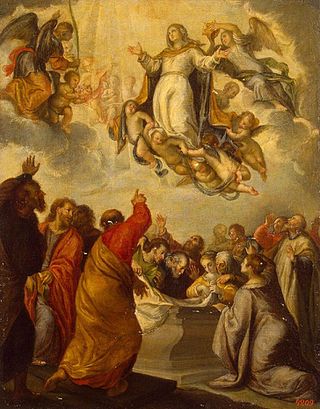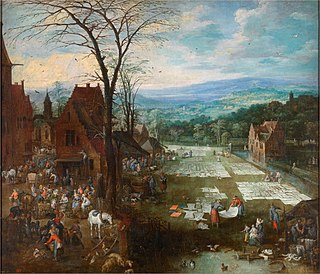
The Adoration of the Magi or Adoration of the Kings or Visitation of the Wise Men is the name traditionally given to the subject in the Nativity of Jesus in art in which the three Magi, represented as kings, especially in the West, having found Jesus by following a star, lay before him gifts of gold, frankincense, and myrrh, and worship him. It is related in the Bible by Matthew 2:11: "On entering the house, they saw the child with Mary his mother; and they knelt down and paid him homage. Then, opening their treasure chests, they offered him gifts of gold, frankincense, and myrrh. And having been warned in a dream not to return to Herod, they left for their own country by another path".

Friar Juan Bautista Maíno, or Mayno was a Spanish Baroque painter.

Juan Ribalta was a Spanish painter of the Baroque period. He was born and died in Valencia. His father, Francisco Ribalta, was a famous painter, active in the style of Caravaggio. Some sources said he was born in Madrid and later moved to Valencia. His mother Inés Pelayo died in 1601. Juan's works and style are similar to that of his father. He later painted Saint Sebastian at the Valencia Cathedral in 1616, later the small Adoration of the Shepherds and St. Peter, he also painted portraits including the poet Gaspar de Aguilar.

José Claudio Antolinez was a Spanish painter of the Baroque period.

Francisco Camilo was a Spanish painter, the son of an Italian immigrant who had settled in Madrid. When his father died, his mother remarried, and Camilo became the stepson of the painter Pedro de las Cuevas.

Sir Peter Paul Rubens was a Flemish artist and diplomat. He is considered the most influential artist of the Flemish Baroque tradition. Rubens's highly charged compositions reference erudite aspects of classical and Christian history. His unique and immensely popular Baroque style emphasized movement, colour, and sensuality, which followed the immediate, dramatic artistic style promoted in the Counter-Reformation. Rubens was a painter producing altarpieces, portraits, landscapes, and history paintings of mythological and allegorical subjects. He was also a prolific designer of cartoons for the Flemish tapestry workshops and of frontispieces for the publishers in Antwerp.

Venus and Adonis is a painting by the Italian late Mannerist artist Paolo Veronese, executed in the early 1580s, now in the Museo del Prado, in Madrid.
Peter Paul Rubens painted the Adoration of the Magi more often than any other episode from the life of Christ. The subject offered the Counter-Reformation artist the chance to depict the richest worldly panoply, rich textiles, exotic turbans and other incidents, with a range of human types caught up in a dramatic action that expressed the humbling of the world before the Church, embodied in Madonna and child. The most notable include:

Peeter Symons or Peeter Simons was a Flemish painter only known for his collaboration with Rubens in 1636 on the commission from the Spanish king Philip IV of Spain to create a series of mythological paintings to decorate the Torre de la Parada, a hunting lodge of the king near Madrid.

The Spanish royal collection of art was almost entirely built up by the monarchs of the Habsburg family who ruled Spain from 1516 to 1700, and then the Bourbons. They included a number of kings with a serious interest in the arts, who were patrons of a series of major artists: Charles V and Philip II were patrons of Titian, Philip IV appointed Velázquez as court painter, and Goya had a similar role at the court of Charles IV.

Flemish Market and Washing Place is an oil-on-canvas painting by Flemish painter Joos de Momper. It was painted in the 1620s, and it might be a collaboration between de Momper and Jan Brueghel the Elder

Landscape with Sea and Mountain is an oil-on-canvas painting by Flemish painter Joos de Momper. It was painted in the early 1620s, and is now in the Museum of Prado in Madrid.

Excursion in the Countryside of Infanta Isabel Clara Eugenia is an oil on canvas painting by Flemish artists Jan Brueghel the Elder and Joos de Momper. It was painted in the first quarter of the 17th century, and is housed at the Museum of Prado, in Madrid.

The Infanta Isabel Clara Eugenia in the Mariemont Park is a large oil on canvas painting by Flemish artists Jan Brueghel the Elder and Joos de Momper. It was painted in the first quarter of the 17th century. The painting is kept in the Museum of Prado in Madrid.

Life in the Countryside is an oil on canvas painting by Flemish artists Jan Brueghel the Elder and Joos de Momper. It was painted between 1620 and 1622. The painting is kept in the Museum of Prado in Madrid.

A Farm is an oil on panel painting by Flemish painter Joos de Momper.

Landscape is an oil on panel painting by Flemish painter Joos de Momper.

Landscape with Skater is an oil on canvas painting by Flemish artist Joos de Momper. The painting is today considered a collaboration between the latter and Jan Brueghel the Elder. It was painted between 1615 and 1625. The painting is kept in the Museum of Prado in Madrid.

Alpine Landscape is an oil-on-canvas painting by Flemish painter Tobias Verhaecht. The painting was completed between 1600 and 1615, and is now in the Museum of Prado in Madrid.

Our Lady of the Rosary is an oil on canvas painting of Our Lady of the Rosary by Bartolomé Esteban Murillo, created c. 1650-1655. It was previously in the El Escorial Monastery and Palacio Real de Madrid and now is held in the Museo del Prado, in Madrid.



















